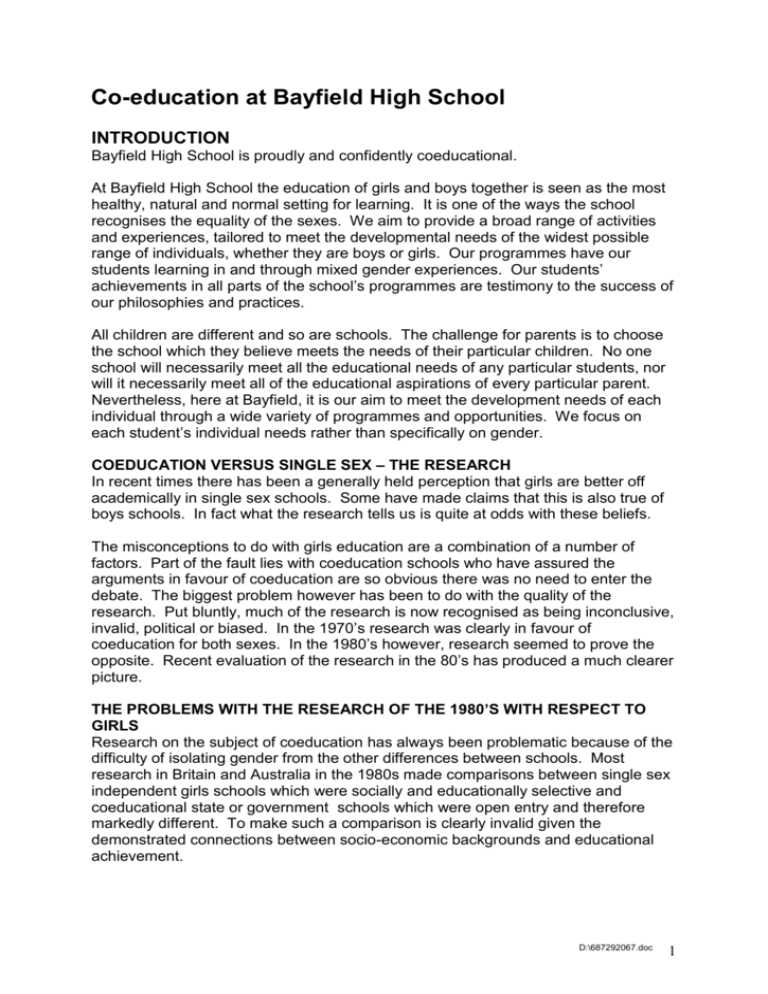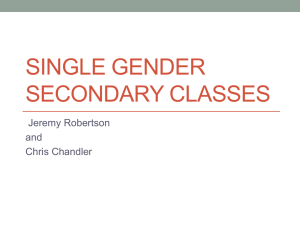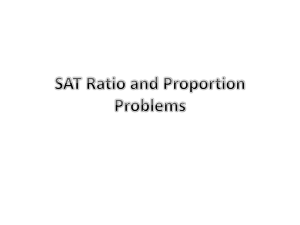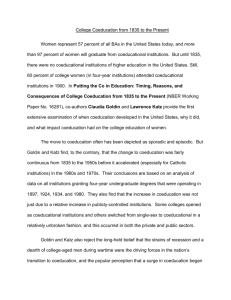
Co-education at Bayfield High School
INTRODUCTION
Bayfield High School is proudly and confidently coeducational.
At Bayfield High School the education of girls and boys together is seen as the most
healthy, natural and normal setting for learning. It is one of the ways the school
recognises the equality of the sexes. We aim to provide a broad range of activities
and experiences, tailored to meet the developmental needs of the widest possible
range of individuals, whether they are boys or girls. Our programmes have our
students learning in and through mixed gender experiences. Our students’
achievements in all parts of the school’s programmes are testimony to the success of
our philosophies and practices.
All children are different and so are schools. The challenge for parents is to choose
the school which they believe meets the needs of their particular children. No one
school will necessarily meet all the educational needs of any particular students, nor
will it necessarily meet all of the educational aspirations of every particular parent.
Nevertheless, here at Bayfield, it is our aim to meet the development needs of each
individual through a wide variety of programmes and opportunities. We focus on
each student’s individual needs rather than specifically on gender.
COEDUCATION VERSUS SINGLE SEX – THE RESEARCH
In recent times there has been a generally held perception that girls are better off
academically in single sex schools. Some have made claims that this is also true of
boys schools. In fact what the research tells us is quite at odds with these beliefs.
The misconceptions to do with girls education are a combination of a number of
factors. Part of the fault lies with coeducation schools who have assured the
arguments in favour of coeducation are so obvious there was no need to enter the
debate. The biggest problem however has been to do with the quality of the
research. Put bluntly, much of the research is now recognised as being inconclusive,
invalid, political or biased. In the 1970’s research was clearly in favour of
coeducation for both sexes. In the 1980’s however, research seemed to prove the
opposite. Recent evaluation of the research in the 80’s has produced a much clearer
picture.
THE PROBLEMS WITH THE RESEARCH OF THE 1980’S WITH RESPECT TO
GIRLS
Research on the subject of coeducation has always been problematic because of the
difficulty of isolating gender from the other differences between schools. Most
research in Britain and Australia in the 1980s made comparisons between single sex
independent girls schools which were socially and educationally selective and
coeducational state or government schools which were open entry and therefore
markedly different. To make such a comparison is clearly invalid given the
demonstrated connections between socio-economic backgrounds and educational
achievement.
D:\687292067.doc
1
Much of the research which appeared to support the superiority of single-sex private
girls school has been noted by scholars as being influenced by the high socio
economic background of the students involved in the studies. For example Payne
and Newton (1990) observe that the academic differences between co-educational
and single sex schools may not be too surprising given that the latter, in many
societies, forms a selective and prestigious minority (p68).
Jones (1991) concludes ‘class and gender intersect’ (p155). In fact the research
supports his assertion that the biggest factor in the educational performance of girls
is the educational qualifications of the girls mother and/or the mother’s educational
aspirations for their daughters.
The issue is further confirmed by boys achievement in external examinations. Girls
have been doing better, regardless of their setting, or external qualifications for
years. The issue here, is of course boys achievement rather than girls and while
results seem to prove that the single sex environment is better academically,
coeducational schools like Bayfield in fact have greater levels of overall achievement
for both boys and girls.
All this is supported by the latest research in Australia. Without a doubt the leading
researchers in the field of coeducation versus single sex education is Dr Judith Gill,
Senior Lecturer in Education at the University of South Australia. She with several
other researchers has revisited all the 1990s research and have reached a significant
conclusion.
Once the factor of ability and socio-economic background are taken into account
there is no empirical evidence to support the belief that in single sex schools girls do
better than their counterparts in coeducation schools in terms of personal confidence
or academic success, including the key subjects of maths, science and technology.
In fact the evidence proves it is the quality of the school which matters. The research
only supports the understanding that there are good and bad schools, some of them
single sex, some of them coeducation. Indeed neither single sex or coeducational
schools can claim girls will perform better academically in their setting. The issues
the parents should use to distinguish school when choosing are whether the school
provides self confidence, self esteem, enjoyment of schooling and good social
attitude when choosing a school.
WHAT ABOUT BOYS
The research on boys education has been consistent right through the 1970’s to the
1990’s. All the conclusions are clear and unanimous. Boys perform better
academically in coeducational setting especially those boys who are struggling
academically. Boys also invariably report great enjoyment and higher self esteem in
coeducational settings and assessments of their social attitudes indicate far fewer
unacceptable sexist attitudes.
D:\687292067.doc
2
OTHER ISSUES
Subject Enrolments
Over the course of time coeducational schools have been accused of producing
polarised course enrolments with more boys enrolling in science and mathematics
type courses and girls taking humanities courses:
Here at Bayfield we pay particular attention to course selection. Staff at Bayfield
monitor subject choices and all students are interviewed to ensure their choice leads
on to a qualification and a career. The same information is given to both girls and
boys.
The research does however support that girls and boys have different learning styles.
Girls prefer an environment which is cooperative where boys are much more
competitive. Again Bayfield acknowledges these differences and in its unique
Learning to Learn Curriculum collaborative and experiential learning styles are very
much emphasised.
It is a requirement of all the staff at Bayfield to recognise the difference in boys and
girls learning styles and react accordingly. Staff are trained in different learning
styles and are expected to adopt a wide range of methodologies. Because of this,
we would argue that both boys and girls are benefiting from the learning styles of the
other and in so doing our coeducational setting is broadening the learning styles of
both genders.
CONFIDENCE AND SELF ESTEEM
In terms of confidence and self esteem it is clear boys benefit from the coeducational
setting. Where there is controversy is about girls education.
A frequent claim of the supporters of single sex schooling for girls is that attendance
at girls-only schools contributes to higher levels of self confidence and self esteem.
No research has proved this.
What is clear is that girls in all educational settings demonstrate a drop in self esteem
from Years 6 - 9 and tend to underestimate their abilities at this age. There can also
be a tendency to form destructive social cliques at this stage of development We are
aware of this at Bayfield and our vertical form system plus our Peer Mediation and
Peer Support system are specially designed to deal with these issues.
HARASSMENT
One of the major findings of the research is that the extremes of boys behaviour are
significantly moderated in a coeducational setting. Significantly, the research on girls
academic performance includes that it is not at the expense of girls performance.
Again the controversy is centred around girls education. Some people have claimed
that the coeducational setting can place girls in a situation where they will be
harassed by boys. However it should not be assumed that such experience is as a
result of mixed schooling, no more than it is a result of mixes anywhere. Harassment
unchecked is the fault of the school and is not an automatic consequence of
coeducation.
D:\687292067.doc
3
Indeed, parents need to note that psychologists argue that non-physical but highly
verbal victimisation associated with isolation tactics in some girls peer groups can be
extremely harmful psychologically. Sadly this sort of harassment can take place in
any school and indeed the desire to escape from such harassment is often asked by
girls seeking to move from single sex schools to Bayfield.
Similarly the stereotype that in coeducational schools boys dominate the classroom
and girls are passive and subservient belies an honest understanding of the realities
of the coeducational setting. In all classrooms in any school, whether it is single sex
or coeducational there are dominate personalities. In coeducational schools there
are dominant girls and there are dominant boys. Equally there are passive girls and
passive boys. As is any social setting, learning to recognise and respond to these
differences in demeanour for both girls and boys is a part of normal growth and
development and inappropriate excesses are more obvious in a coeducational
setting. Where parents have concerns for either boys and girls being appropriately
prepared for social interaction at post-school age, there are great advantages in how
students learn by interacting in a natural setting such as a coeducational school.
Parents need to be aware that girls are not helpless as the claim they would be
dominated by boys, seems to imply. Girls are in fact a significant focus in our school
in all its aspects, as leaders and as academic successes. For parents to support this
claim is for them to demean their own daughters.
SOCIAL ENVIRONMENT
There is a consistent message in all the research that both students and teachers
perceive the coeducational environment as more pleasant and socially relaxed.
(Schuder et al 1988, Payne and Newton 1989) Dale (1974) demonstrated that the
average coeducational school was a happier community for both staff and students
than the average single sex school, with less tension. Payne and Newton (1990)
have commented in that students are generally reported as favouring coeducational
schools and all several surveys reporting coeducational students are more likely to
comment on the pleasant social climate or atmosphere of the schools. (p68)
SOCIAL ATTITUDES
Research in this area is very sketchy. What exists, supports the contention that
single sex education, especially for boys, promotes the continuation of traditional
sexist attitudes rather than breaking them down.
Kenway and Walker (1986) argue against single sex education from a perspective of
social responsibility because boys sexist attitudes are reinforced by their
segregation. In the long run this clearly would be neither to society nor girls’ or boys’
benefit.
Coeducation by its family nature has the advantage that boys and girls receive the
same opportunities, is especially within families and in so doing emphasises family
unity. Anecdotal evidence also supports that boys and girls in coeducational settings
are less likely to become involved in sexual relationships outside of school and are
more likely to have a balanced attitude to these matters.
D:\687292067.doc
4
PREPARATION FOR TERTIARY STUDIES
There is no substantial research which looks at the impact of single sex versus
coeducational schools on a student preparation for tertiary studies. There does
appear to be evidence that students in coeducational schools do better because the
world of work and tertiary are entirely mixed sex. It could therefore be argued that
coeducational settings would prepare girls better especially as it cannot be claimed
that educational settings give girls any academic advantage.
THE OVERALL TREND
In countries all over the world the vast majority of girls and boys are educated in
coeducational settings. In fact single sex schools have only been a common practice
in upper and middle class English education and systems derived from it or in
settings where the segregation of girls is clearly for sexist reasons. In England, the
‘home’ of single sex education, there has been a substantial swing to coeducation
and similarly in the United States a substantial number of so called ‘elite’ single sex
schools have gone coeducational in the last decade. Even here in New Zealand
there is a growing trend in the North Island for single sex schools to become
coeducational at Year 13. A reflection, perhaps of their understanding that
coeducation is better preparation for tertiary study and the world of work.
EDUCATION ISSUES FOR BOYS
The research on coeducation versus single sex education for boys is clear in all
areas; boys are better of in the coeducational setting in terms of academic
achievement, confidence and self esteem, behaviour and enjoyment of the social
environment. It can also be argued they will be less likely to adopt sexist attitudes
and they are better prepared for tertiary studies.
The focus, however, on girls education has perhaps overshadowed significant issues
to do with boys education. The research show that boys, in whatever setting, are not
doing as well as girls nor are they enjoying it as much. In particular boys are overrepresented at the bottom end of the NCEA tables, and beyond school in the
unemployment and crime figures. There are also serious issues to do with the health
of adolescent boys, particularly in relation to substance abuse and risk taking
behaviour.
It is up to all schools to address these issues. Because Bayfield is coeducational it
does provide an advantage in terms of enjoyment and monitoring behaviour and
attitudes. Our staff are also trained to deal with boys and their learning.
CONCLUSION
The best evidence Bayfield can produce in relation of the value of coeducation for
girls and boys is the testament of the students themselves. Surveys of students and
their parents show an over 86% approval for all elements of the school, including
those aspects we would define as socialisation and safety. In particular each year
we get many students transferring to us from single sex schools and this indicates
their satisfaction at having done so. We have very few students going to single sex
schools because they feel they cannot cope in a coeducational setting.
D:\687292067.doc
5
Our staff are especially trained to provide appropriate support for both genders as
they pass through the various stages of emotional, social, intellectual and physical
development.
We would strongly encourage parents who may have concerns about coeducation to
speak to some of our students as well as the staff. Students will be able to provide
first-hand commentary about the benefits, the effects, the opportunities, the
challenges and their likes and dislikes in a completely open and honest way. Staff
will equally be able to provide comment about the opportunities and issues which
confront our young people and the approach we adopt to address them.
Below are some references to the research we refer to in the article and perhaps
some reading you might like to undertake for yourself.
Biddulp S (1994) Manhood – Finch Publishing
Brown R & Fletcher R (ed) (1995) Boys ain Schools – Finch Publishing
Dale R R (1974) Mixed or Single Sex Schools? Routledge & Kega London
Gill J (1989) A Review of the Evidence on Single Sex Versus Coeducation Debate
and an Annotated Bibliography of the Research
Gill J (1992) Which Way to School? – Key address to the AHISA Conference October
1992
Gill J (1992) Coeducation: Past Problems and Future Thinking – in Education A
Jones J (1990) Outcome of Girls School: Unravelling Some Differences – Australian
Journal of Education 34(2)
Kenway J & Willis S (1986) Counting Sexism in the Single Way: a flawed proposition
in Porter P Gender and Education, Deakin University Australia
Marsh H.W. et al (1989) From Single Sex to Coed Schools in Leder G C Sampson
SU Educating Girls, Allen & Unwin, Sydney
D:\687292067.doc
6











